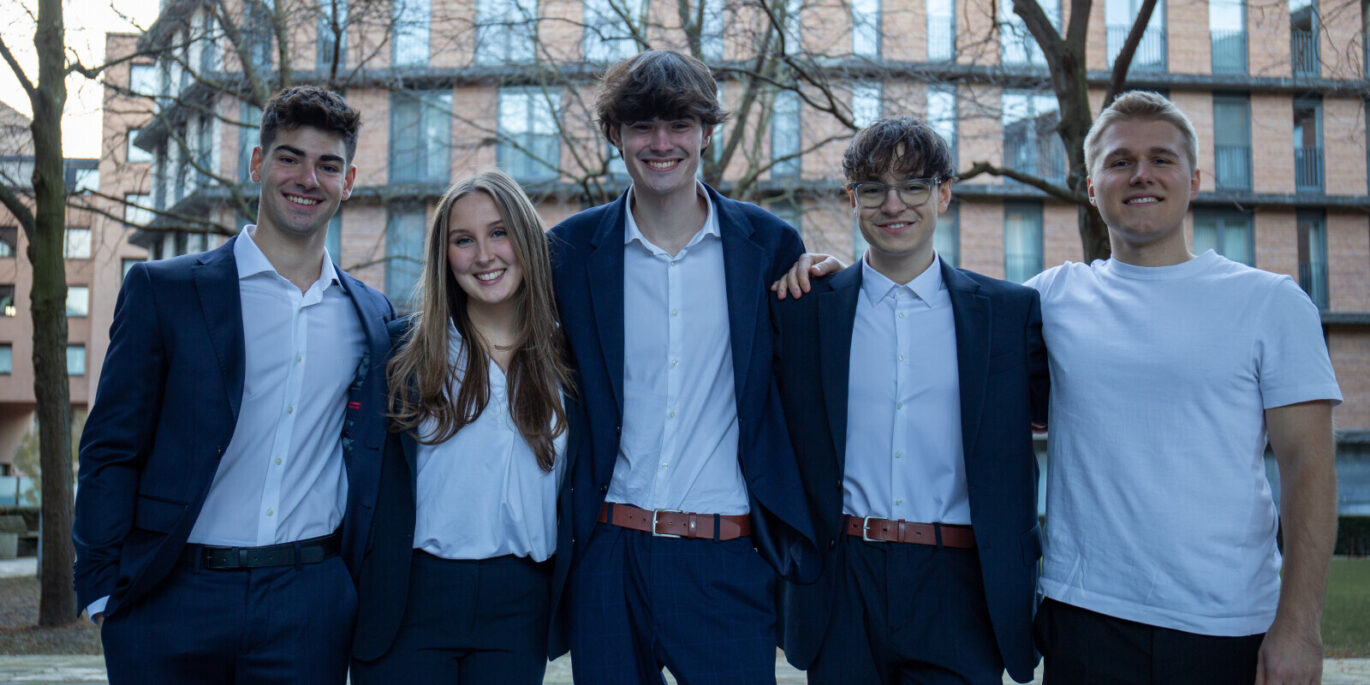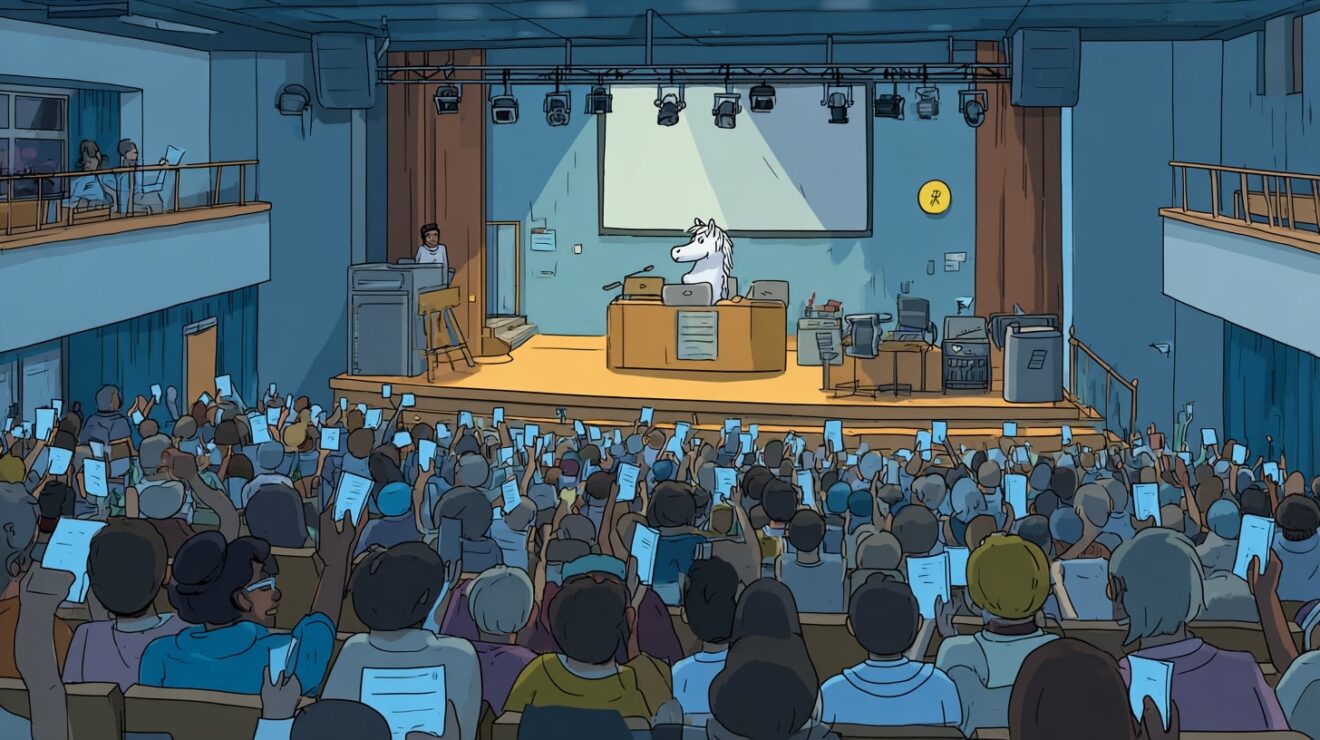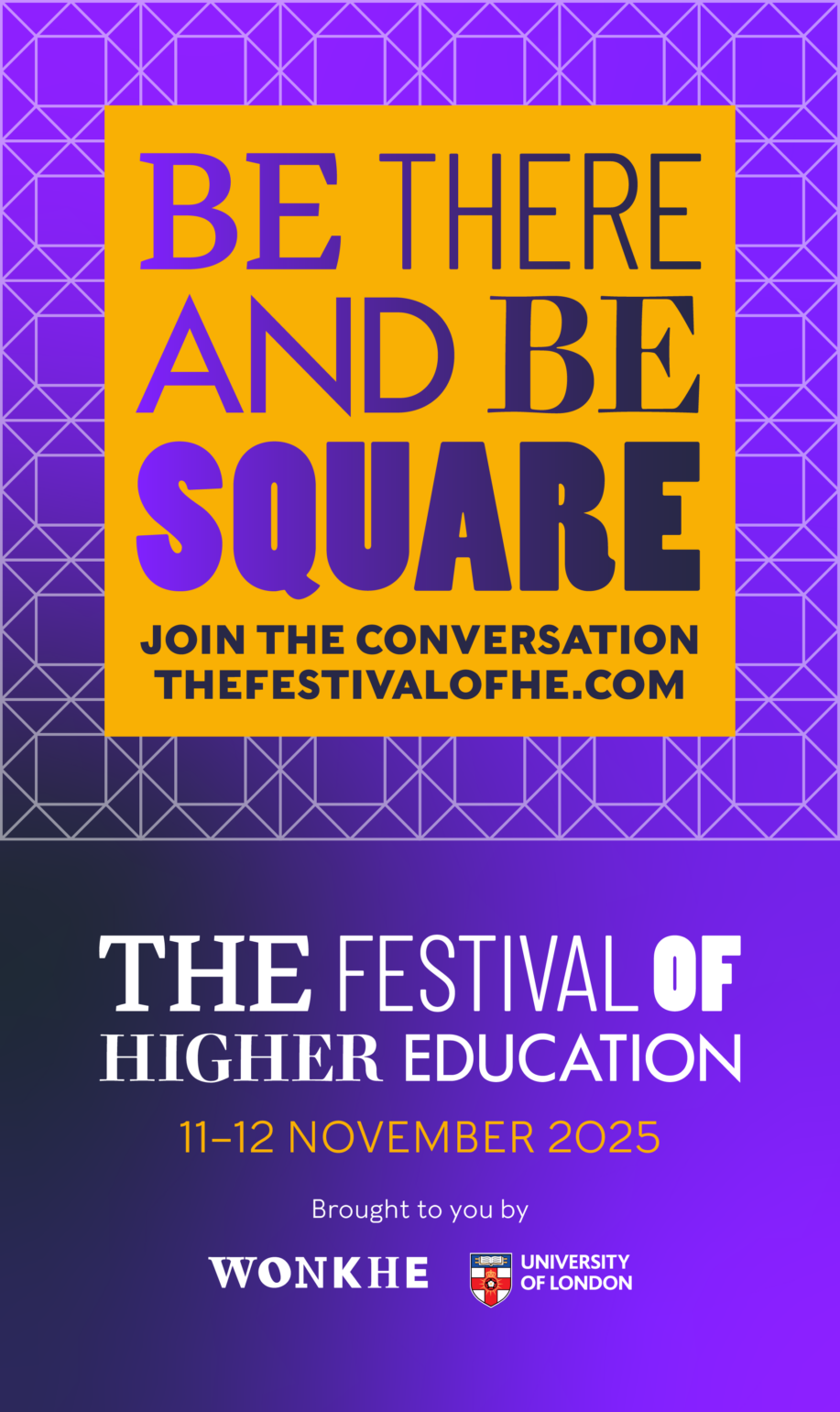One question hanging over Celtic Connections was fundamental – how do you create meaningful student representation when traditional structures seem increasingly disconnected from students’ actual lives?
Sinéad Daly’s (CEO at UWS SU) presentation (slides) of their democracy review offered an answer that challenges everything we think we know about student democracy.
Rather than tinkering with existing systems, UWS has built something entirely different – centred on academic communities rather than constitutional committees. But the real revelation came when Eilidh Cowan, President of the UWS Midwifery Society, demonstrated what student engagement looks like when the scaffolding actually works.
UWS didn’t start with ideology – they started with data. Their election turnout figures told a stark story – undergraduate participation had collapsed to just 10% by 2025, while complex democratic structures remained largely invisible to the students they claimed to represent. Only 39% of students knew who their representative was, despite extensive rep networks.
The numbers revealed deeper problems. Students with disabilities reported lower satisfaction with representation. At the London campus, 84% of students said they weren’t encouraged to stand as representatives. Student reps felt overwhelmed during peak periods when their voice was most needed.
“Student voice structures hasn’t changed in decades – but our students have,” Daly explained. As a widening access university, UWS students juggle work, caring responsibilities, placements, and study in ways that traditional representation models simply don’t accommodate.
But buried in their data was something more hopeful. While formal democratic structures struggled, academic societies – particularly the Midwifery Society – demonstrated something powerful about student-led community building that overcame every barrier the institution could throw at them.
The midwifery miracle
What Eilidh Cowan described shouldn’t work. The UWS Midwifery Society operates from a relatively remote campus. Students are constantly on placement. They’re mature students with caring responsibilities. The programme is demanding. Every traditional barrier to student engagement applies.
Yet the society doesn’t just survive – it thrives in ways that put most students’ unions to shame.
The secret starts before students even arrive. The society runs pre-term events ensuring nobody turns up on Day One alone. “We want to make sure everyone feels welcome and gets to know each other,” Cowan explained, recognising that belonging must be actively constructed, not passively hoped for.
Different students lead different social media platforms – not because of arbitrary role allocation, but because they’re good at specific platforms and connect with different demographics. Instagram for visual updates, WhatsApp for placement tips, TikTok for reaching younger students. It’s organic specialisation based on genuine skill and interest.
The society’s “social programme” transcends the traditional events calendar. Their coffee mornings aren’t just networking – they’re lifelines for students navigating emotional and academic challenges. Some events are simply “everyone going for a coffee,” recognising that meaningful connection often happens in the simplest settings.
They display infectious passion for their profession, taking part in midwifery conferences and winning awards. The President was proud of low attrition rates but still wanted them lower, demonstrating the kind of ownership and accountability that formal representatives rarely achieve.
Their podcast emerged organically when a student started posting voice notes in the WhatsApp group with placement tips, calling them “her wee podcasts.” Rather than being formalised into irrelevance, this became a valued resource shaped by student needs rather than institutional expectations.
Most tellingly, while technically they “don’t represent students” – there’s a separate rep scheme for that – the President found ways around such bureaucratic limitations. With backing from the main SU team and university, the society functions as a genuine students’ union for midwifery students, fitting what Daly termed “a communitarian vision of student engagement.”
Crucially, without this society, what are the chances that midwifery students – with their unusual timetables, caring responsibilities, specific academic needs, and remote campus – would find meaningful support through individual initiatives from SU or university departments? The scaffolding provided by academic identity creates possibilities that generic student services simply cannot match.
The power of peer support
The Midwifery Society demonstrates something fundamental about how students support each other when institutional barriers are removed. They’ve created what amounts to a parallel support system that addresses academic, professional, and personal development simultaneously.
Students share placement experiences, warn about challenging rotations, celebrate successes, and provide emotional support during difficult cases. They organise study groups, mock exams, and skills practice sessions. They fundraise for professional development opportunities and support members facing financial hardship.
When pregnancy and infant loss awareness week comes around, they don’t just post about it – they create memorial trees, provide resources, and offer genuine support to those affected. Their Christmas fundraiser raised £1,176 for Simba, a charity supporting bereaved parents, demonstrating how academic identity can drive meaningful social action.
The society’s approach to inclusivity goes beyond policy statements. They actively consider different learning styles, family commitments, financial constraints, and placement schedules when planning activities. Events happen at different times, in different formats, with different participation requirements, ensuring multiple entry points for engagement.
“School plays sell out” captures something essential about community ownership. When students create and lead their own communities around shared academic interests, engagement follows naturally because the community serves genuine needs rather than institutional requirements.
Academic societies as democratic infrastructure
UWS’s insight was making academic societies central to their democratic structure rather than peripheral to it. Instead of asking students to engage with union structures, they’ve built union structures around where students naturally congregate – their courses and schools.
The transformation is comprehensive. The new model replaces a central Student Council with School Assemblies open to all students within each academic area. Part-time Vice Presidents for each school make leadership more accessible while staying connected to academic journeys. Campus and Society Forums create informal spaces for collaboration. An expanded Executive Committee brings together elected officers, school representatives, liberation officers, and society leaders.
This isn’t just structural reorganisation – it’s philosophical transformation. From representation that extracts feedback to communities that generate belonging. From democratic processes that students must learn to navigate, to democratic participation that emerges from existing relationships.
Voter turnout increased has 50% since 2021, reaching a record 2,720 votes in 2025. More significantly, undergraduate participation increased 181% from 432 to 1,217 between 2023 and 2025 – precisely the demographic most alienated by traditional approaches. Student satisfaction with representation reached 73% for how the Union represents views to the University and 71% for campaigning on student issues.
But the Midwifery Society reveals what these numbers represent in practice. When students see their academic identity reflected in democratic structures, engagement becomes natural rather than effortful. The society’s success demonstrates that students will overcome extraordinary barriers – remote campuses, caring responsibilities, demanding placements – when the community serves genuine needs.
The controversial innovation
Perhaps most striking is UWS’s introduction of Candidate Approval Committees – student-led panels that review candidates for elected positions to ensure basic experience and communication skills. This addresses a persistent challenge highlighted throughout Celtic Connections: how do you maintain democratic access while ensuring elected representatives are equipped for increasingly complex institutional roles?
“If I’m voting for someone to represent me, I want to know they’re ready,” captures the student sentiment driving this innovation. The process includes full training on fairness and bias, appeals mechanisms through external trustees, and participation limited to already-engaged students like society members and representatives.
This tackles the uncomfortable reality that traditional democratic ideals often produce representatives who struggle with institutional complexity, while those best equipped for such roles may lack the political skills for traditional campaigning. The Midwifery Society President exemplifies this tension – clearly capable of sophisticated advocacy and community building, but operating outside formal representative structures.
The Midwifery Society’s approach to developing student leadership offers lessons for formal democratic structures. Rather than expecting students to arrive with representation skills, they create multiple pathways for participation and development.
Students start by contributing to WhatsApp groups, progress to leading specific events or social media accounts, take on committee roles, and eventually may seek society leadership. Each stage builds confidence and expertise while serving immediate community needs. Nobody becomes President without understanding both the student experience and institutional landscape.
The society’s relationship with academic staff provides another model for institutional engagement. Rather than adversarial relationships or token consultation, they’ve developed genuine partnerships where student voice influences curriculum delivery, placement arrangements, and professional development opportunities.
Their success in reducing attrition rates demonstrates how academic societies can address institutional priorities while serving student needs. When students feel supported by peers who understand their specific challenges, they’re more likely to persist through difficult periods. The society provides what institutional support services often cannot – targeted, peer-led assistance from people who’ve navigated identical challenges.
Policy development through community engagement
UWS’s new approach to policy development reflects lessons learned from the Midwifery Society’s organic approach to advocacy. Rather than students drafting individual motions in isolation, they’re moving toward collaborative policy development rooted in community insight.
Working groups and student-led think tanks will explore policy areas, drawing on evidence from School Assemblies, Campus Forums, and society experiences. The Midwifery Society’s advocacy around placement conditions, professional development opportunities, and student welfare demonstrates how academic communities naturally identify and address systemic issues.
This represents a fundamental shift from reactive to generative policy-making. Instead of responding to problems after they emerge, academic societies can identify emerging challenges and develop solutions before they become crises. The Midwifery Society’s proactive approach to supporting students through difficult placements exemplifies this preventative approach.
The session didn’t shy away from implementation complexities, many of which the Midwifery Society has navigated successfully. Cultural change takes time – the society’s current strength developed over several years of consistent leadership and community building. Part-time officers need robust support systems – the society demonstrates how peer mentorship can supplement institutional support.
University committee structures must adapt to distributed rather than centralised representation. The Midwifery Society’s experience of working around formal representative limitations suggests institutions often struggle to accommodate organic student leadership that doesn’t fit predetermined categories.
Most significantly, the model demands substantial staff investment. UWS SU has created a Senior Student Democracy & Insights Coordinator role specifically to support implementation – acknowledging that democratic innovation requires professional expertise, not just good intentions. The Midwifery Society benefits from SU and university backing, but their success suggests that modest institutional support can enable extraordinary student-led activity.
The financial implications extend beyond staff costs. Academic societies require funding for events, resources, professional development, and community-building activities. The Midwifery Society’s fundraising success – £1,176 for pregnancy loss support – demonstrates both student commitment and resource limitations.
Broader implications for student engagement
The UWS approach addresses themes emerging throughout Celtic Connections discussions, with the Midwifery Society providing concrete examples of abstract principles. How do you create meaningful participation when students face unprecedented time poverty? The society shows how engagement rooted in academic identity can overcome scheduling constraints that derail generic activities.
How do you build representation that reflects rather than excludes diverse student experiences? The society’s inclusive approach to events, communication, and leadership development demonstrates how academic communities can accommodate different participation styles and capacity levels.
How do you move beyond consultation toward genuine co-creation? The society’s influence on placement arrangements, curriculum delivery, and professional development shows how student voice can shape rather than simply comment on institutional decisions.
Their three-pillar framework – participation with purpose, representation that reflects, engagement through connection – finds expression in the Midwifery Society’s daily practice. Students participate because activities serve genuine needs, not because they should engage with democratic processes. Representation reflects student diversity because the society actively accommodates different circumstances and participation styles. Engagement occurs through connection because academic identity provides natural community bonds.
The communitarian vision
Embedded in UWS’s reforms is a particular vision of what student representation is for, exemplified by the Midwifery Society’s approach to community building. Not just feedback mechanisms or customer satisfaction systems, but genuine community development that supports both individual growth and collective action.
This aligns with broader European approaches to student engagement, where representation focuses on enabling student communities rather than managing student complaints. When the Midwifery Society President spoke about students making “both the student experience and the profession better,” she captured something essential about civic responsibility that transcends institutional boundaries.
The society demonstrates how academic identity can drive social action beyond immediate student concerns. Their pregnancy loss support work, professional development initiatives, and peer mentorship activities contribute to wider professional and social communities. Students develop not just as consumers of education, but as future professionals with responsibilities to their disciplines and society.
The risk, acknowledged throughout the session, is that community-based approaches may reproduce existing inequalities if participation remains limited to those with sufficient time and resources. But the Midwifery Society’s inclusive practices suggest that engagement rooted in academic identity may be more accessible than engagement requiring separate democratic literacy.
Their success with mature students, those with caring responsibilities, and students facing financial constraints demonstrates how academic communities can accommodate diverse circumstances in ways that generic democratic structures often cannot.
Scaling the model
The challenge facing UWS is whether the Midwifery Society’s success can be replicated across different academic areas. Midwifery students share clear professional identity, placement experiences, and career trajectories that create natural community bonds. Business students or humanities undergraduates may lack such obvious commonalities.
However, the society’s principles – organic leadership development, peer support, professional relevance, inclusive participation – apply across academic areas. The key insight is building from existing student interests rather than imposing external democratic frameworks.
The new School Assembly structure creates space for academic communities to develop their own approaches to engagement and representation. Rather than mandating specific activities or structures, UWS is providing scaffolding that different student communities can use according to their needs and circumstances.
Early pilot data suggests this approach resonates beyond professional programmes. Undergraduate participation increases indicate that academic identity provides more compelling engagement opportunities than traditional democratic processes, even for students without clear professional pathways.
What emerged most clearly from both the formal presentation and the Midwifery Society example was a growing recognition that student representation, as traditionally conceived, may be the wrong frame entirely.
When academic societies naturally develop peer support, professional development, community connection, and advocacy capacity, the question becomes how unions can enable and amplify these functions rather than replacing them with alternative democratic structures.
The Midwifery Society demonstrates how effective advocacy emerges from strong communities rather than sophisticated constitutional arrangements. Students capable of challenging institutional decisions are those who’ve developed confidence, knowledge, and networks through meaningful participation in academic communities. The society’s President speaks with authority about placement conditions, professional development needs, and student welfare because she’s embedded in the community experiencing these issues daily.
This doesn’t eliminate the need for institutional representation, but it suggests that formal democratic structures should support rather than supplant organic student leadership. The message was clear – if you want students to engage with democracy, build democracy around what students already engage with. The Midwifery Society proves it’s possible.


















